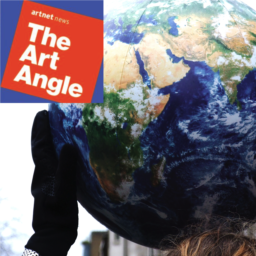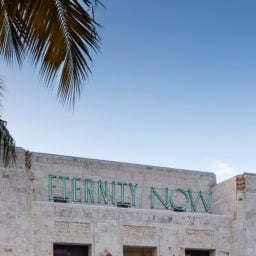Asking about carbon footprints and climate change concerns will not make you hugely popular at an art fair, I have learned.
On the heels of the Lithuanian Pavilion’s climate change-themed opera “Sun & Sea (Marina)” winning the coveted Golden Lion award at the Venice Biennale, one might have expected that the issue would get some play in Basel this year. After all, given that the fair opens just a few weeks after the Biennale, one art-market adage is “see in Venice, buy in Basel.”
The issue, certainly, was in the air as the 2019 fair opened. In fact, as visitors filed into Art Basel on the fair’s first public day, students and young artists staged a performance aimed at raising climate awareness outside the fair. The action was organized by the Paris foundation Art of Change 21.
Still, despite both the critical acclaim around “Sun & Sea (Marina)” and the pressure from the young activists—and despite the concern displayed in no less than two panels on the topic in Art Basel’s Conversations section—the so-called “green hush” seems to hold in the stands of the world’s premier art fair.
Talking Change
The hesitancy is understandable, sort of. The questions around the art-world’s carbon footprint are deeply uncomfortable for everyone, this writer included. It brings up questions of our very existence as an industry. Professionals of all stripes travel around the world multiple times per year for trips lasting under a week, and the whole supply-and-demand chain, as it currently stands, calls for art to be regularly shipped from A to B, usually as quickly as possible. (“You know the art world way—I am on a plane every two weeks,” I overheard one fairgoer explain.)
Short-term events like Art Basel are known to generate waste in the form of bubble wrap, crates, and temporary building materials. It makes sense that, despite the alarms going off outside about an imminent climate emergency, the art world has a vested interest in keeping a business-as-usual approach for as long as possible.
“We have been very accepting that art travels around and that it can get there in 24 hours notice,” says Andrew Stramentov, director of Rok Box, a new company pioneering reusable shipping crates, at an Art Basel panel yesterday on the carbon footprint of contemporary art. “Unless the collectors are asking questions, there is very little imperative for the system to change.”
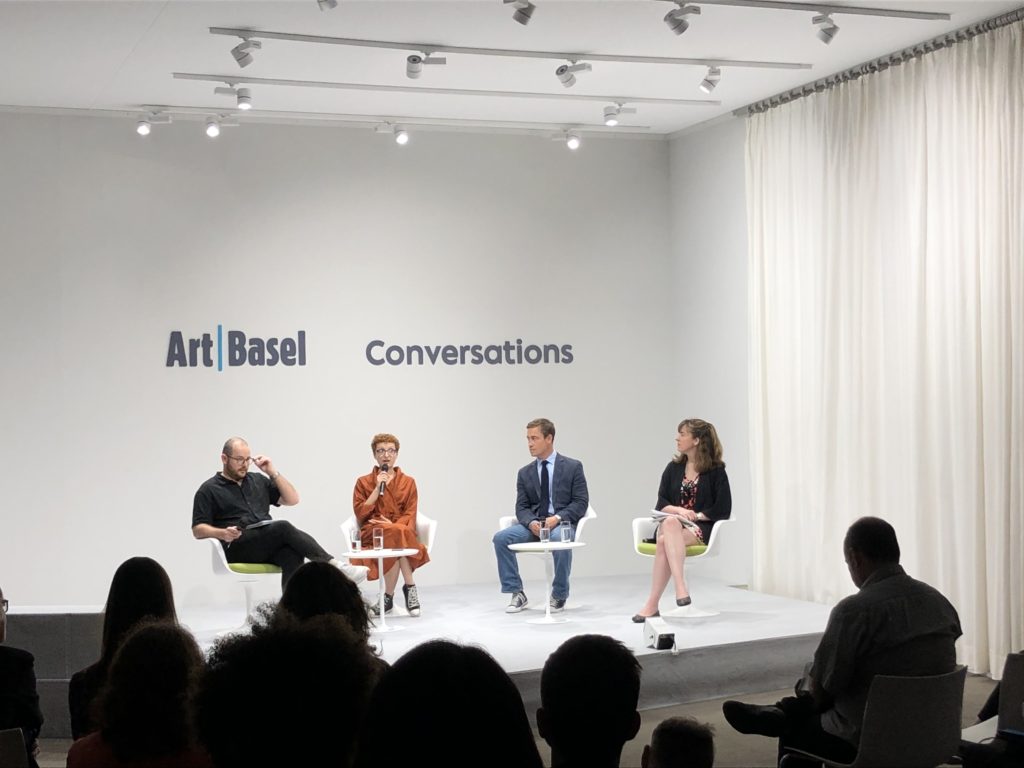
“The Carbon Footprint of Contemporary Art” at Art Basel Conversations. Photo: Kate Brown
Stramentov spoke alongside panelists Lucia Pietroiusti, curator of General Ecology at Serpentine Galleries and curator of the Lithuanian Pavilion, and Catherine Bottrill, head of the Creative Green Programme at the London-based charity Julie’s Bicycle. The trio only got to the more touchy question of art fairs in the last quarter of the conversation.
Stramentov stressed that collectors have a lot of agency in how green a gallery transaction can be. He suggested collectors start asking galleries to use greener shipping companies to start. Bottrill stressed that everyone should be thinking about the efficiency of the buildings hosting such events.
The role of art fairs in the climate crisis was raised before this year’s Art Basel even began. “Art fairs can play a role in putting forward the visceral and emotional side of the issues, but they are not inherently environmentally friendly,” Art Basel’s director Marc Spiegler told FT when asked about the fair’s ecological considerations, seeming to concede that the very foundation of an art fair is just not good for the environment.
Still, Basel is making small steps. It is trying to reuse materials and minimize waste, while its sister design fair has stopped using plastic bottles at booths. In general, though, they don’t want to tell their clients how to behave.
White Cube, Green Hush
When it comes to the art in Basel, the so-called “visceral and emotional side” of the issue of climate change just isn’t moving the conversation. Nearly every gallerist I spoke to said that collectors are just not that interested in climate change as a topic.
The subject is different, in this way, from other hot-button issues that are raging in and beyond the art world, like representation, race, and gender politics. Those seem to have informed the kind of art on view—and translated into sales.
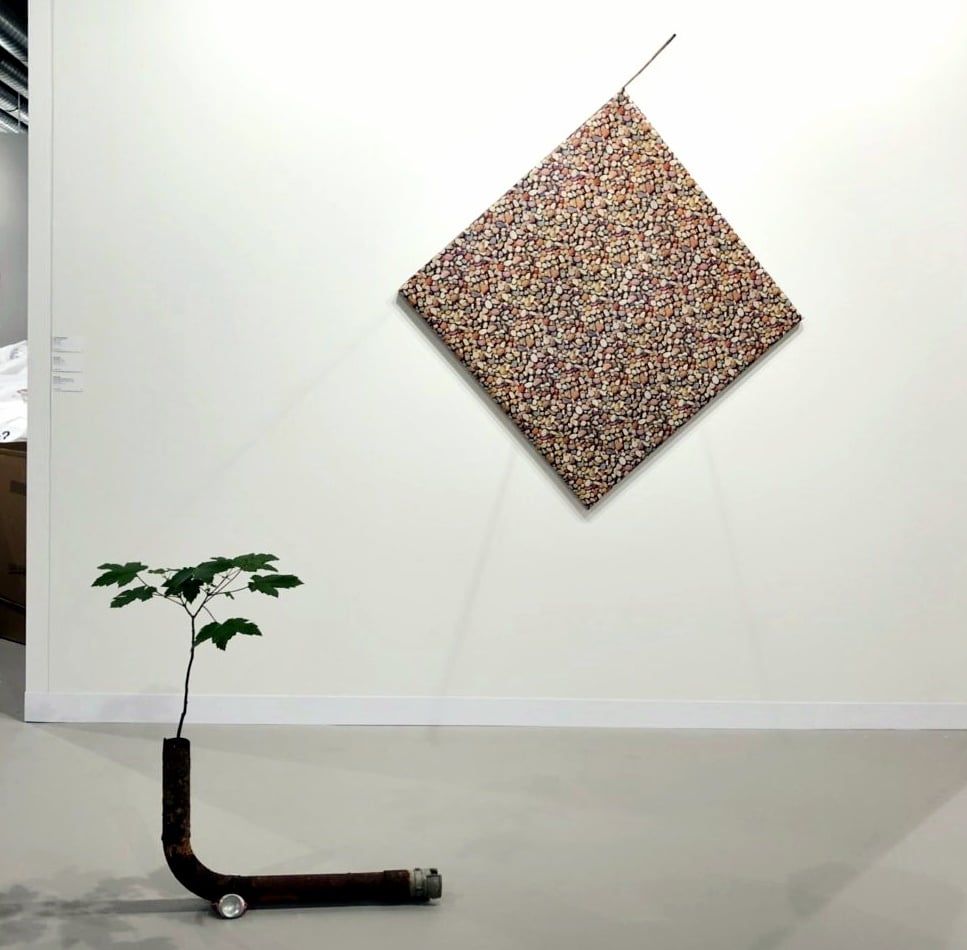
ArtConcept’s presentation at Art Basel 2019.
“Sexuality is more interesting as a topic than breathing,” says Olivier Antoine from Parisian gallery Art:Concept with a smile, when I ask him why climate hasn’t become the same kind of talking point for collectors. The gallery’s own booth provides a graceful approach to the topic without being heavy-handed. Artist Michel Blazy has been working with living organisms since the early 1990s, and here his work Decanalisation features a living plant in it. In terms of gallery operations, Antoine says they tried to bring as little as possible to Art Basel this year.
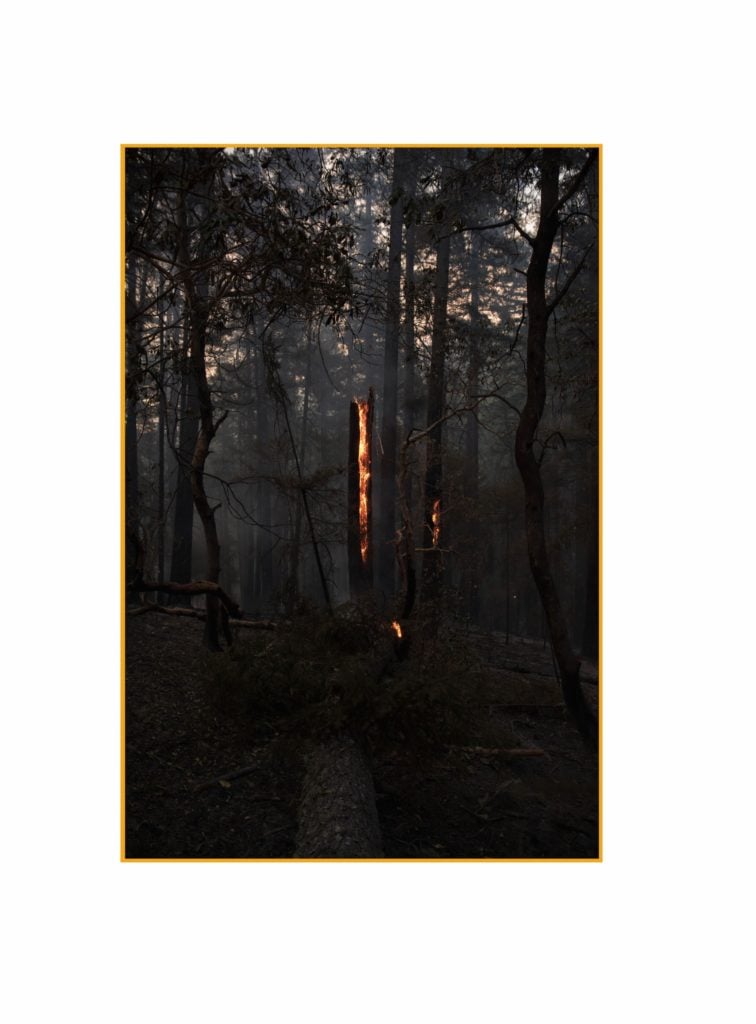
Julius von Bismarck, Fire with Fire (2019). Image courtesy Sies + Höke.
Over at Düsseldorf-based Sies + Höke, a gallery representative explained that two large photographs by German artist Julius von Bismarck of peaceful-looking burning forests in California were actually not about climate change. They offer a different perspective, capturing the sense that fires are part of the natural life cycle of a forest. That may be true, but it’s not exactly an either/or question: Climate change and the ongoing droughts in an already dry state have undoubtedly aggravated the problem of wildfires (as two other LA-based dealers told me later in the day).
At least in the two-minute pitch from Sies + Höke, the takeaway seemed to be that climate change is not a big problem—and, also, aren’t forest fires just beautiful? (The gallery says they have been thinking about their own carbon footprint, but have not come up with any solutions.)
By the end of the second preview day yesterday, June 12, one of the two large works by von Bismarck, which were priced between €16,000 and €22,000, had been acquired by Germany’s federal art collection. I wondered if the pitch I got was the selling point.
Nothing to See Here
“I think you have to be really careful about how you frame this,” said art advisor Lisa Schiff. “You cannot make the one percent or the one percent-adjacent feel terrified or feel guilty, in my opinion. If you do that, they shut down. Climate change is very real and terrifying. If you give people hope and empower them to make change that is realistic in scope, then they do it. So many people I know care deeply about it, but it is paralyzing.”
When you get right down to it, is bringing up the ecological crisis directly in terms of art or art transactions, a faux-pas? A lot of dealers were hesitant to connect works on view to the subject, as if to do so would box them in.
“No, no, definitely not. There is no direct or indirect reference to that issue,” said a salesperson from Marian Goodman gallery when I asked if any of the works in their large booth were speaking to the topic of climate change in any way. Even if it wasn’t the main talking point, I found the certainty surprising, considering the presence of a large photograph of industrial imagery by Thomas Struth or even John Baldessari’s Hot & Cold series, which consists of a painting of a volcano paired beside an iceberg—the short phrases coupled beneath them render these representations of fantastic nature almost trivial.
At Turin gallery Franco Noero, the reaction was similar. A mobile comprised of bag tags from various flights by Jac Leirner had nothing to do with human mobility and ecology—not even just slightly. I was missing the point. Several other dealers had similar responses, as if I were bringing up an aesthetic that good artists wouldn’t want to be associated with, despite the fact that it is not an aesthetic, but rather an overarching theme that impacts politics, questions of consumption, and natural phenomena.
The Accidental Conversation
In the plaza outside the fair, I spoke to Cecilia Alemani, chief curator of High Line Art in New York City, who has curated Alexandra Pirici’s work Aggregate. She also gave me an unequivocal no when I asked if Pirici’s performance in any way touched on the subject of humanity’s impact on nature.
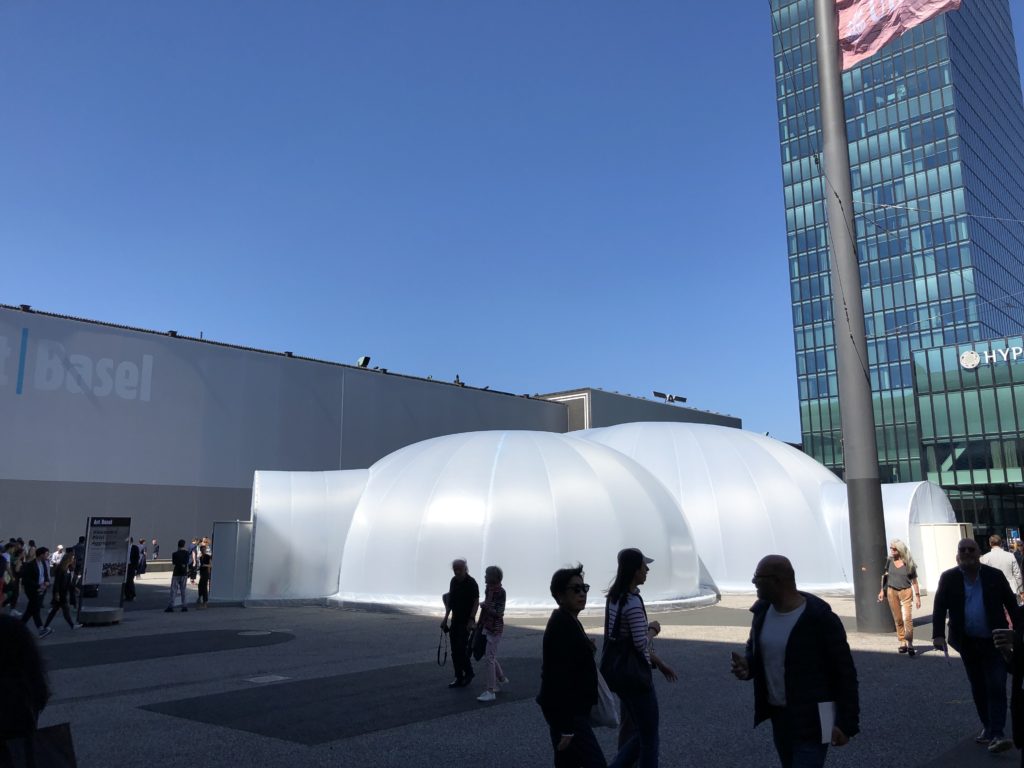
Exterior of Alexandra Pirici’s Aggregate. Photo: Kate Brown
Despite that, when watching this piece I found that Pirici’s powerful work, which is on view for four hours each day of the fair and held inside a large igloo-like venue inspired by Buckminster Fuller’s geodesic dome (which will be recycled after the fair), was deeply emblematic of the environmental concerns. After all, these are just human concerns, when you get right down to it.
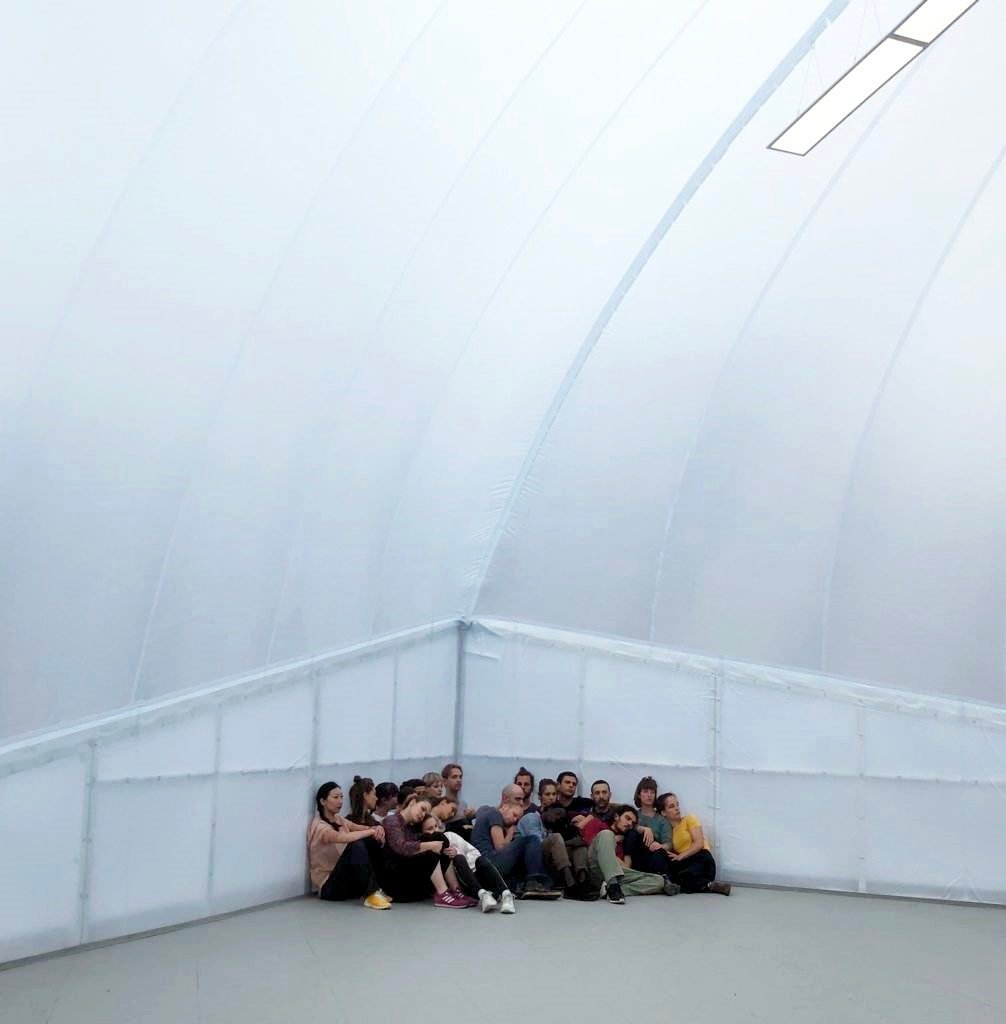
View of Alexandra Pirici’s Aggregate. Photo: Kate Brown
Inside, around 60 casually dressed performers blended in and out of the crowd, shifting between viewer and observer. They imitated bird calls, extinct animal sounds, and performed pop songs like Depeche Mode’s Enjoy the Silence, as the performers held onto each other and repeated “all I ever wanted, all I ever needed is here, in my arms…”
The truth is that ecologically minded work, when it is subtle, searing, and communicative, can resonate. In the main section of Art Basel inside, there are also a scattering of thought-provoking works, including Berlin gallery neugerriemschneider’s booth, which was completely dedicated to the concept of the wave. The cornerstone work was by Ai Weiwei, and it features a porcelain wave. A large series of Olafur Eliasson’s pictures taken inside glacier holes felt deeply connected to his recent project Ice Watch.
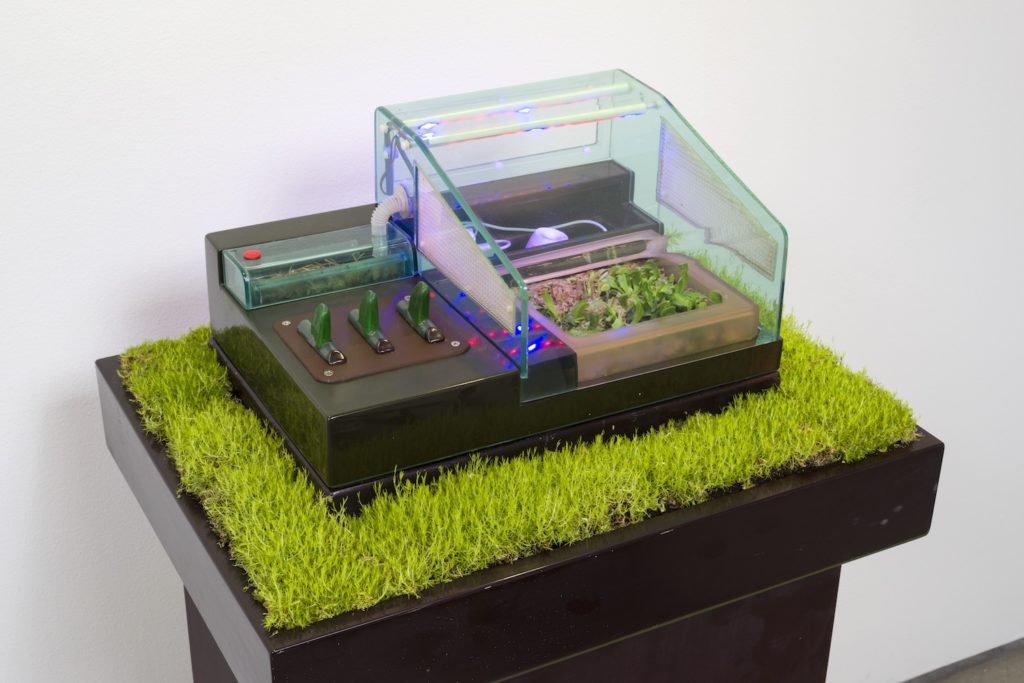
Carl Cheng, Supply and Demand at Philip Martin Gallery. Courtesy of the artist and Philip Martin Gallery, Los Angeles.
At Los Angeles gallery Philip Martin, a solo presentation of living works by California artist Carl Cheng spoke to natural phenomena, corporate culture, and the human impact on the environment without falling into the didactic or alarmist categories that everyone seems to be deeply afraid of at the Messeplatz. Cheng has been navigating these issues at the intersection of technology and nature for over five decades. His sculptural containers, which ranged from $8,000 to $45,000, even feature living organisms planted in and around them.
Of course, dealing with such matters symbolically is only the tip of the iceberg. When I asked about what the galleries are themselves doing to mitigate their own carbon footprint, I got shrugs. (“What are we supposed to do, stay home?” a West Coast American dealer asked me when I brought up the question.) Galleries, artists, and art fair directors all need to change their behaviors, and they all seem to know that, too, which is why they probably cringe at the question (as I do).
The carbon created by coming to the fair, if you traveled by plane from basically anywhere in Europe, is substantial. With one flight from New York to Europe alone, a traveler has reached half their carbon footprint for the year. The whole issue threatens Art Basel’s very raison d’être.
Setting the Agenda
Continua’s popular booth had a statement piece that touched on the subject, called Agenda 2030, by Arte Povera elder statesman Michelangelo Pistoletto. His piece was an update on one of his best-known sculptures Venus of the Rags from the late 1960s, but its new title is in reference to the UN’s sustainable development agenda. Here in Basel, the Roman goddess sculpture is leaning on a pile of colorful plastic bags, not textiles. By the end of the second VIP preview day, the work, which is available for €1 million, was not yet sold.
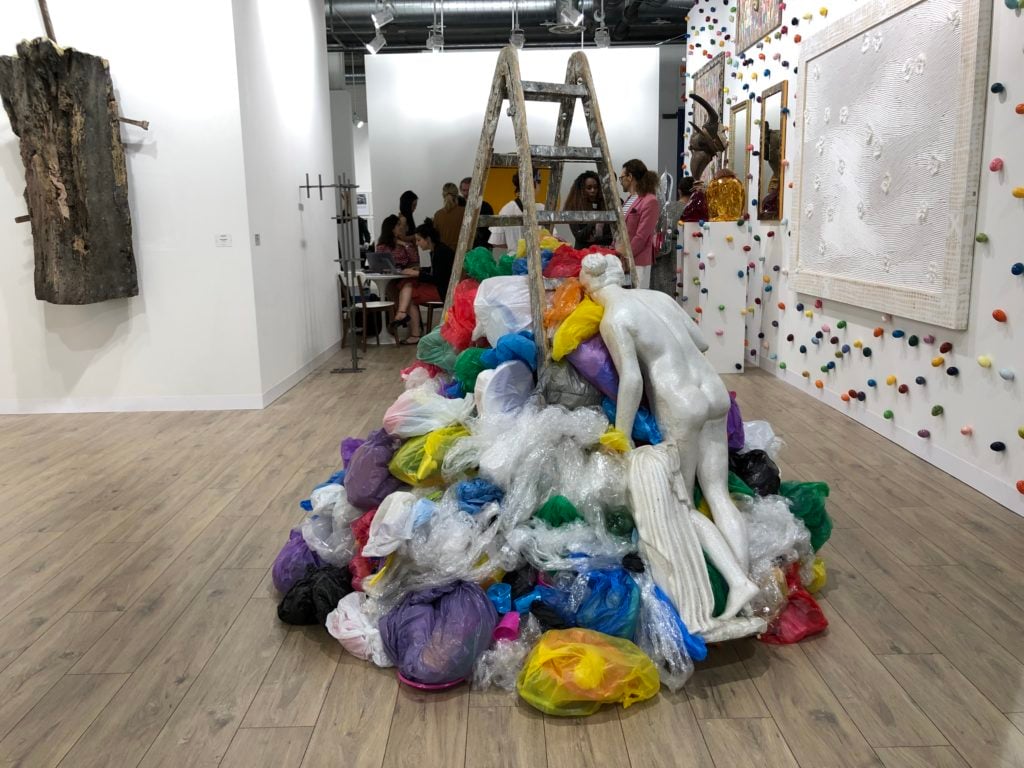
Michelangelo Pistoletto Agenda 2030 (1967-2019) at Galleria Continua.
London dealer Kate MacGarry acknowledged environmental art is not good business. “Environmental art has always had this didactic stigma,” she says. “It’s a bit of a minefield. I didn’t show it this year, because I also don’t want to use it as a marketing tool. But in general, it is not a go-to theme right now, though I wish it was.”
At a panel as a part of Art Basel Conversations called “Talk About the Weather,” addressing how artists and institutions can use their platforms to deal with ecological issues, MacGarry elaborated. “Our current way of working is not sustainable and we need to make changes,” MacGarry told the crowd. “How can we give the green companies in our industry that are doing good work a better platform? It would be nice to see Art Basel do more with this. And it would be nice to see their partner BMW only showcasing the i3,” she added, referring to the company’s emissions-free car. “We’ve been living in an age of ethical apathy.”
“This is the one thing that we all have in common,” MacGarry continued. “No one is exempt from this, and the wealthier you are, the more responsible you are—everyone at a place like Art Basel is complicit.”
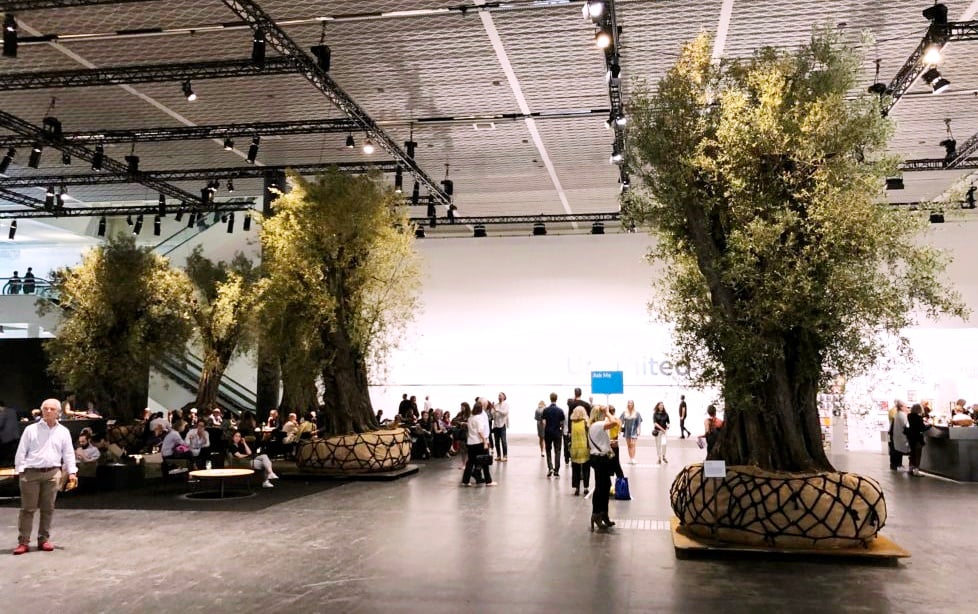
Enzo Ene’s UseAbuse at the Art Basel’s entrance. Photo Kate Brown.
At the entrance hall to the fair, Swiss garden architect and tree collector Enzo Enea has installed a grove of large olive trees—one is 650 years old—as an artistic intervention. They are still standing, for now, like quiet beasts looming over the scene, as collectors, gallerists, artists, and journalists pound by them to clamor inside the fair. The subtle presence of these ancient living trees, alongside the talks, can be read as a testament that Art Basel and its participants are starting to think about how to tackle this issue.
But is it happening fast enough? The biggest statements, it seems, are not yet for sale.











